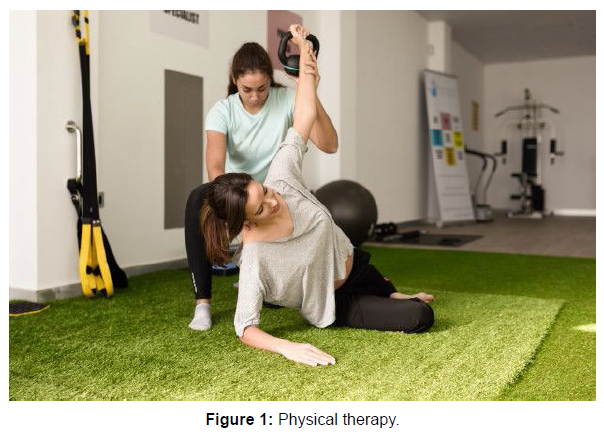Practice and Defining the Roles of Physical Therapists
Received: 22-Apr-2023 / Manuscript No. JPAR-23-99878 / Editor assigned: 25-Apr-2023 / PreQC No. JPAR-23-99878 / Reviewed: 09-May-2023 / QC No. JPAR-23-99878 / Revised: 12-May-2023 / Manuscript No. JPAR-23-99878 / Published Date: 19-May-2023 DOI: 10.4172/2167-0846.1000504 QI No. / JPAR-23-99878
Abstract
Physical therapy is services provided by physical therapists to individuals and populations to develop maintain and restore maximum movement and functional ability throughout the lifespan. The service is provided in circumstances where movement and function are threatened by ageing, injury, pain, diseases, disorders, conditions and/or environmental factors and with the understanding that functional movement is central to what it means to be healthy.
Keywords: Rehabilitation; Prognosis; Public health; Physical activity; Movement behaviours; Health needs
Keywords
Rehabilitation; Prognosis; Public health; Physical activity; Movement behaviours; Health needs
Introduction
Physical therapy involves the interaction between the physical therapist, patients/clients, other health professionals, families, care givers and communities in a process where movement potential is examined/ assessed and goals are agreed upon, using knowledge and skills unique to physical therapists. Physical therapists are concerned with identifying and maximising quality of life and movement potential within the spheres of promotion, prevention, treatment/ intervention and rehabilitation [1]. These spheres encompass physical, psychological, emotional, and social wellbeing. Physical therapists are qualified and professionally required to undertake a comprehensive examination/assessment of the patient/client /population or needs of a client group, evaluate the findings from the examination/assessment to make clinical judgments regarding patients/clients, formulate a diagnosis, prognosis and plan, provide consultation within their expertise and determine when patients/clients need to be referred to another professional, implement a physical therapist intervention/ treatment programme and education in agreement with the patient/ client, evaluate and re-evaluate the outcomes of any interventions/ treatments/education, make recommendations for self-management, collaborate with health professionals and other key stakeholders [2]. The physical therapist’s extensive knowledge of the body and its movement needs and potential is central to determining strategies for diagnosis and intervention [3].
Methodology
The practice settings will vary according to whether the physical therapy is concerned with health promotion, prevention, treatment/ intervention or rehabilitation as shown in (Figure 1). The scope of physical therapist practice is not limited to direct patient/client care, but also includes public health strategies, advocating for patients/ clients and for health, supervising and delegating to others, leading, managing, teaching, research, developing and implementing health policy at the local, national and international levels [4]. Physical therapists operate as independent practitioners, as well as members of health service provider teams, and are subject to the ethical principles of WCPT. They are able to act as first contact practitioners, and patients/ clients may seek direct services without referral from another health professional. Physical therapists are guided by their own code of ethical principles [5]. Thus, they may have any of the following purposes, promoting the health and wellbeing of individuals and the general public/society, emphasising the importance of physical activity and exercise and the facilitation of such activities, preventing impairments, activity limitations, participatory restrictions and disabilities in individuals at risk of altered movement behaviours due to health factors, socio-economic stressors, environmental factors and lifestyle factors, providing interventions/treatment to restore integrity of body systems essential to movement, maximise function and recuperation, minimise incapacity, and enhance the quality of life, independent living and workability in individuals and groups of individuals with altered movement behaviours resulting from impairments, activity limitations, participatory restrictions and disabilities, modifying environmental, home and work access and barriers to ensure full participation in one’s normal and expected societal roles [6].
Discussion
The education and clinical practice of physical therapists will vary according to the social, economic, cultural and political contexts in which they practise [7]. However, it is a single profession, and the first professional qualification, obtained in any country, represents the completion of a curriculum that qualifies the physical therapist to use the professional title and to practise as an independent professional as shown in (Figure 2). WCPT has developed this international description of physical therapy based on the following principles, which it encourages its member organisations to use in defining physical therapy practice nationally [8]. WCPT advocates that a description must respect and recognise the history and roots of the profession, build on the reality of contemporary practice and the existing and growing body of research [9]. Practitioner – the term practitioner encompasses all roles that a physical therapist may assume such as patient/client care, management, research, policy maker, educator and consultant, allow for variation in: cultures, values and beliefs; health needs of people and societies; and the structure of health systems around the world, use terminology that is widely understood and adequately defined, recognise internationally accepted models and definitions, provide for the on-going growth and development of the profession and for the identification of the unique contribution of physical therapy and its evolving scope of practice, acknowledge the importance of physical therapy, related medical and social sciences within physical therapy curricula at all levels, emphasise the need for practice to be evidence-based whenever possible, appreciate the inter-dependence of practice, research and education within the profession, recognise the need to review continuously the description as the profession changes in response to the health needs of society and the development of knowledge in physical therapy, anticipate that work will flow from this description as it is used to assist in the development of curricula and identification of areas for research [10]. Where is physical therapy practised? Physical therapy is an essential part of the health and community/welfare services delivery systems. Physical therapists practise independently of other health care/service providers and also collaboratively within interdisciplinary rehabilitation programmes that aim to prevent movement disorders or maintain/restore optimal function and quality of life in individuals with movement disorders [11]. Physical therapists practise in and across a wide variety of settings. What characterises physical therapy? The following assumptions are embedded in this description and reflect the central components of physical therapy [12]. Physical therapists are autonomous practitioners prepared through professional entry-level physical therapy education. Physical therapists exercise their professional judgement to reach a diagnosis that will direct their physical therapy interventions/treatment, education and rehabilitation of patients/clients/populations [13]. Diagnosis in physical therapy is the result of a process of clinical reasoning that results in the identification of existing or potential impairments, activity limitations, participation restrictions, environmental influences or abilities/disabilities. The purpose of the diagnosis is to guide physical therapists in determining the prognosis and most appropriate intervention/treatment/education strategies for patients/clients and in sharing information with them [14]. In carrying out the diagnostic process, physical therapists may need to obtain additional information from other professionals. If the diagnostic process reveals findings that are not within the scope of the physical therapist’s knowledge, experience or expertise, the physical therapist will refer the patient/client to another appropriate practitioner. Individuals have the capacity to change as a result of their responses to physical, psychological, social and environmental factors. Body, mind and spirit contribute to individuals’ views of themselves and enable them to develop an awareness of their own movement needs and goals. Ethical principles require the physical therapist to recognise the autonomy of the patient/client or legal guardian in seeking his or her services. Movement is an essential element of health and wellbeing and is dependent upon the integrated, co-ordinated function of the human body at a number of levels. Movement is purposeful and is affected by internal and external factors. Physical therapy is directed towards the movement needs and potential of individuals and populations. Physical therapists may direct their interventions to specific populations.
Conclusion
Populations may be nations, states and territories, regions, minority groups or other specified groups. An integral part of physical therapy is interaction between the physical therapist and the patient/client/family or caregiver to develop a mutual understanding of their needs. This kind of interaction is necessary to change positively the body awareness and movement behaviours that may promote health and wellbeing. Members of inter-disciplinary teams also need to interact with each other and with patients/clients/families and caregivers to determine needs and formulate goals for physical therapy intervention/treatment.
Acknowledgement
None
Conflict of Interest
None
References
- Bidaisee S, Macpherson CNL (2014) Zoonoses and one health: a review of the literature. J Parasitol 2014:1-8.
- Cooper GS, Parks CG (2004) Occupational and environmental exposures as risk factors for systemic lupus erythematosus. Curr Rheumatol Rep EU 6:367-374.
- Parks CG, Santos ASE, Barbhaiya M, Costenbader KH (2017) Understanding the role of environmental factors in the development of systemic lupus erythematosus. Best Pract Res Clin Rheumatol EU 31:306-320.
- M Barbhaiya, KH Costenbader (2016) Environmental exposures and the development of systemic lupus erythematosus. Curr Opin Rheumatol US 28:497-505.
- Cohen SP, Mao J (2014) Neuropathic pain: mechanisms and their clinical implications. BMJ UK 348:1-6.
- Mello RD, Dickenson AH (2008) Spinal cord mechanisms of pain. BJA US 101:8-16.
- Bliddal H, Rosetzsky A, Schlichting P, Weidner MS, Andersen LA, et al. (2000) A randomized, placebo-controlled, cross-over study of ginger extracts and ibuprofen in osteoarthritis. Osteoarthr Cartil EU 8:9-12.
- Maroon JC, Bost JW, Borden MK, Lorenz KM, Ross NA, et al. (2006) Natural anti-inflammatory agents for pain relief in athletes. Neurosurg Focus US 21:1-13.
- Birnesser H, Oberbaum M, Klein P, Weiser M (2004) The Homeopathic Preparation Traumeel® S Compared With NSAIDs For Symptomatic Treatment Of Epicondylitis. J Musculoskelet Res EU 8:119-128.
- Ozgoli G, Goli M, Moattar F (2009) Comparison of effects of ginger, mefenamic acid, and ibuprofen on pain in women with primary dysmenorrhea. J Altern Complement Med US 15:129-132.
- Raeder J, Dahl V (2009) Clinical application of glucocorticoids, antineuropathics, and other analgesic adjuvants for acute pain management. CUP UK: 398-731.
- Świeboda P, Filip R, Prystupa A, Drozd M (2013) Assessment of pain: types, mechanism and treatment. Ann Agric Environ Med EU 1:2-7.
- Nadler SF, Weingand K, Kruse RJ (2004) The physiologic basis and clinical applications of cryotherapy and thermotherapy for the pain practitioner. Pain Physician US 7:395-399.
- Trout KK (2004) The neuromatrix theory of pain: implications for selected non-pharmacologic methods of pain relief for labor. J Midwifery Wom Heal US 49:482-488.
Indexed at, Google Scholar, Crossref
Indexed at, Google Scholar, Crossref
Indexed at, Google Scholar, Crossref
Indexed at, Google Scholar, Crossref
Indexed at, Google Scholar, Crossref
Indexed at, Google Scholar, Crossref
Indexed at, Google Scholar, Crossref
Indexed at, Google Scholar, Crossref
Indexed at, Google Scholar, Crossref
Indexed at, Google Scholar, Crossref
Indexed at, Google Scholar, Crossref
Indexed at, Google Scholar, Crossref
Citation: Cain J (2023) Practice and Defining the Roles of Physical Therapists. J Pain Relief 12: 504. DOI: 10.4172/2167-0846.1000504
Copyright: © 2023 Cain J. This is an open-access article distributed under the terms of the Creative Commons Attribution License, which permits unrestricted use, distribution, and reproduction in any medium, provided the original author and source are credited.
Share This Article
Recommended Conferences
42nd Global Conference on Nursing Care & Patient Safety
Toronto, CanadaRecommended Journals
Open Access Journals
Article Tools
Article Usage
- Total views: 1517
- [From(publication date): 0-2023 - Apr 02, 2025]
- Breakdown by view type
- HTML page views: 1304
- PDF downloads: 213


